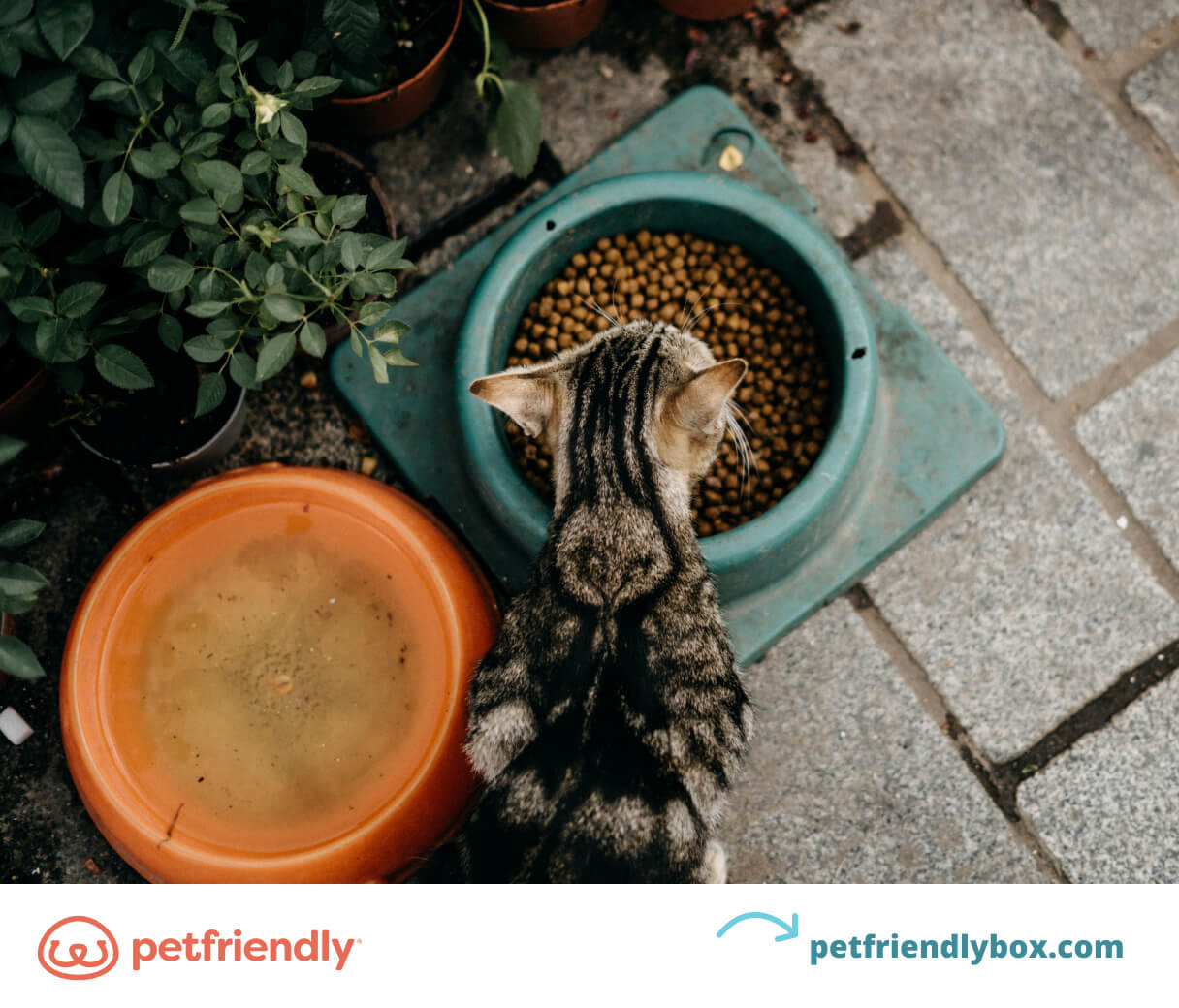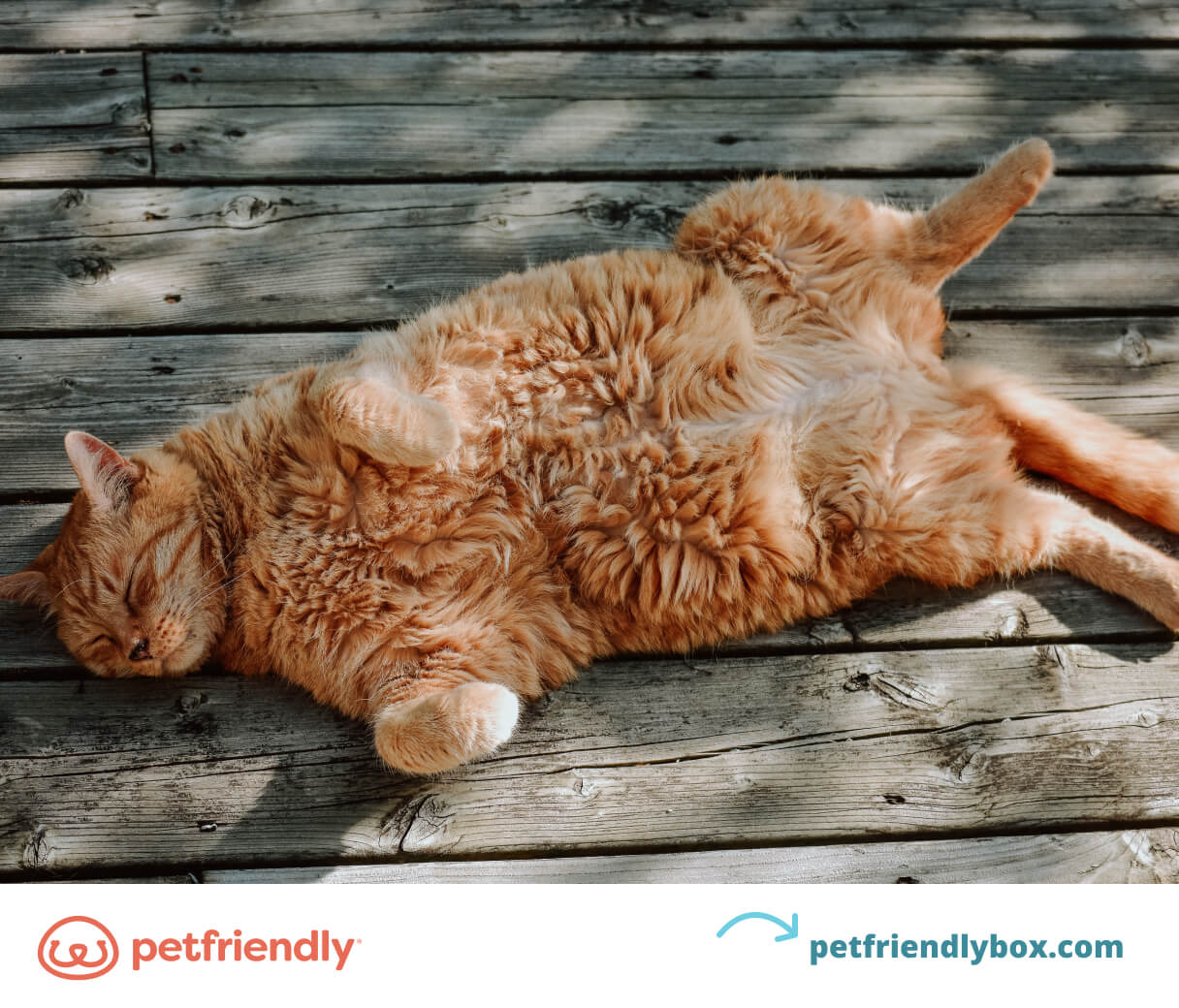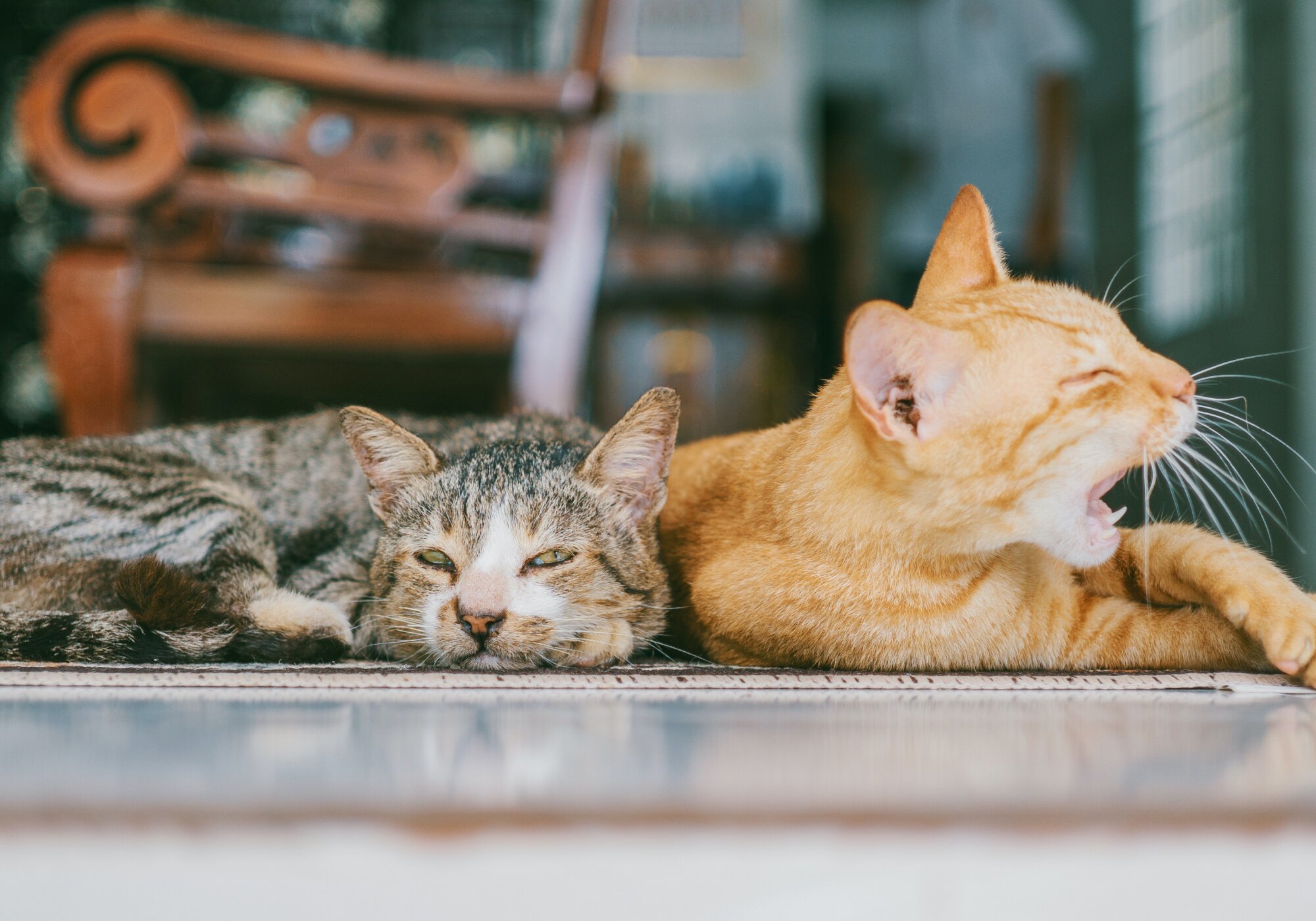Cats are known for their ability to keep their health needs met without constant attention from their owners. But, there are some common cat health problems that even your fastidious feline can't prevent.
Many common cat diseases and problems can affect your cat's quality of life. Some of these health problems are incurable. But, there are some treatments for these more common cat diseases that can soothe the symptoms of your sick cat.

Here are the 14 most common cat diseases and health issues — plus suggested treatments for infected cats.
1. Fleas

Cat fleas carry diseases and cause skin irritation and allergic reactions in cats. The cat flea life cycle takes anywhere from 2 weeks to 1 year, depending on the climate.
Fleas jump from one host to the next, laying eggs on various surfaces. Cats can contract fleas from:
- Other infected animals or pets
- Humans and their clothing
- Backyards
- Kennels and pet hotels
- Pet bedding and toys
Fleas can quickly turn into a frustrating issue for a cat owner. If your cat has fleas, they may have irritated skin from flea dirt and saliva. Over time, your cat risks developing anemia if their flea issue sticks around for too long.
Suggested Treatment
Pesky fleas can be difficult to get rid of. Fleas can live up to more than a year in certain climates. But, there are three simple solutions to get rid of your cat's flea problem for good.
Apply flea & tick treatment.
To get rid of fleas, you'll need to start with an effective flea and tick preventative. Apply treatment year-round to keep your cat protected from fleas.
If you have a multi-cat household, be sure to treat every cat. An untreated cat could bring fleas back into your home, creating a new issue.
Dog medications are different from those made for cats. Be sure to read the label carefully before applying treatment to your cat.
Clean your home.
If you have an active flea infestation in your home, you will also need to treat and safeguard your home. Vacuum your floors, furniture, and your pet's bedding. Then, soak soft fabrics including bedding, blankets, and soft toys in soapy water to remove fleas.
Use a household spray.
Spray and wipe down hard surfaces and toys with disinfectant. When all surfaces are dry, use a household spray with an insect growth regulator (IGR). IGRs get rid of any active fleas and help prevent future infestations.

2. Tapeworm

Tapeworms are common intestinal parasites that affect indoor and outdoor cats. Tapeworms infest a cat's intestinal tract when a cat ingests an intermediate host like fleas or rodents.
There are three common tapeworms found in cats:
- Dipylidium caninum
- Taenia taeniaeformis
- Echinococcus
Cats with infections of intestinal parasites may show common symptoms like scooting, vomiting, diarrhea, and weight loss. Although rare, cats with major infestations can suffer from other health issues like intestinal blockages.
Suggested Treatment
Tapeworm spreads through fleas. So, the best way to protect your cat is by using a preventative flea control treatment.
If your cat does contract tapeworm, the main method of treatment is through deworming medication. Deworming medications prescribed by your vet are safe for cats. And, they are effective at getting rid of tapeworms.
3. Dental disease
+(1).jpg)
Dental diseases that affect your cat's teeth and gums are common as they grow older in age. This is due to the gradual wear and tear of their teeth. Here are some clinical signs that your cat may be suffering from dental disease:
- Red and swollen gums
- Pawing at the mouth
- Refusal to eat hard food
If you suspect your cat might have dental health issues, visit your vet for a cat check-up. The three most common dental diseases in cats are:
Gingivitis
Gingivitis occurs when the gums around your cat's teeth become inflamed. Plaque buildup is the most common cause of inflamed gums.
Periodontitis
If left untreated, gingivitis can develop into a more serious health problem — periodontitis. Periodontitis occurs when inflammation weakens the tissues attached to your cat's teeth and gums. Cats with periodontitis may experience loose teeth or tooth loss.
Tooth resorption
Tooth resorption is the most common cause of tooth loss in cats. This occurs when your cat's tooth structure breaks down. This dental disease can be painful for cats.
Suggested Treatment
The most common forms of dental disease are preventative and treatable. Brushing your cat's teeth every two weeks can help prevent plaque buildup.
If your cat has a dental disease, managing your cat's pain is the first step of treatment. To ease pain and discomfort, your vet may suggest removing the damaged tooth. Removing a damaged tooth will also prevent the condition from spreading to other teeth.
4. Feline lower urinary tract disease (FLUTD)

One of the more common cat health problems is FLUTD. FLUTD occurs when there is a defect in the structure or function of your cat's bladder. When your cat's bladder is not structured correctly, it can cause problems in your cat's life.
UTIs in cats, inflammation, and diet are the most common causes of lower urinary tract diseases. Because there are many causes of FLUTD, the origin of the disease can be difficult to diagnose.
The most common signs of FLUTD include:
- Painful urination
- Frequent urination
- Inappropriate urination
- Bloody urine (litter box blood)
- Frequent licking of the genital area
Female and male cats can get feline lower urinary tract disease. But, overweight, older cats that eat dry food and use an indoor litter box are the most susceptible to FLUTD.
Your vet will perform a physical exam and a urinalysis to determine the source of your cat's urinary tract problem. Your vet might also suggest other testing including urine cultures, x-rays, or ultrasounds.
Suggested Treatment
FLUTD treatment depends on your cat's health issues and symptoms. Here are common treatments related to feline lower urinary tract disease.
Fluid therapy
Your vet can prescribe stone-dissolving diets to get rid of urinary stones. Vets can also flush your cat's bladder with sterile fluids to pass urinary stones manually or perform surgical removal.
Dietary improvements
If your vet is unable to determine the cause of your cat's FLUTD, they may diagnose your cat with FIC. To resolve symptoms of FIC, your vet may suggest a dietary change.
Catheterization
If your cat has a urethral obstruction, they will not be able to urinate. Urinary obstructions are life-threatening, so visit your veterinarian immediately for treatment. They can perform a catheterization to remove an obstruction.
5. Feline obesity

Like humans, obesity is a common cat health issue. Domestic cats are more likely to develop obesity than outdoor cats.
But how do you know if your cat is overweight? vets use the nine-point scoring system to determine if a cat is overweight. Obese cats typically score an eight or above.
Obesity hinders a cat's quality of life. Obese cats may struggle to exercise and experience painful muscle and joint conditions like:
- Osteoarthritis
- Hip dysplasia
- Diabetes
Obesity has become a serious issue for cats due to free-feeding. Free feeding is when cat parents leave large amounts of dry food out for their cats to eat throughout the day.
Suggested Treatment
To combat this issue, it's important for cat parents to have designated feeding times for their cats. Feeding your cat an appropriate amount of food twice daily will prevent them from over-eating.
Today's Veterinary Practice suggests a treatment plan and follow-up vet visits. Owners should also commit to the following actions to treat obese cats:
- Provide regular exercise for your pet
- Ensure all members of your household are on board with your pet's treatment plan
- Use praise and attention instead of treats as positive reinforcement
6. Feline diabetes

Insulin regulates your cat’s blood sugar levels. When a cat has diabetes, the condition affects the cat's ability to produce insulin. A lack of insulin leads to elevated blood glucose levels.
There are two types of diabetes your cat can contract:
- Type I: A decrease in insulin production causes high blood sugar levels.
- Type II: Blood sugar levels become elevated due to a cat's inability to respond to insulin.
In both forms of diabetes, your cat's cells cannot access the nutrients they need. This is because the insulin in your cat's body cannot transport the sugar from their blood into the cells that need it for energy.
Here are some common signs of diabetes in cats:
- Weight loss (despite a good appetite)
- Excessive thirst
- Increased urination
- Nerve damage in the hind limbs
According to the Cornell Feline Health Center, obese, male cats are up to four times more likely to develop Type II diabetes. So, it's important for cat owners to keep their cats at a healthy weight through physical activity and a healthy diet.
Suggested Treatment
There is no cure for diabetes in cats. But, there are safe options for treatment including:
Monitoring
A cat owner can track their cat's blood glucose curves at home. This will help determine how much insulin your cat needs.
Your cat's blood glucose should be within an acceptable range outlined by your vet. Cat parents should also track their cat's weight, water intake, and appetite.
Insulin therapy
Unlike humans, an oral medication that reduces blood sugar is ineffective for cats. Diabetic cats can get insulin injections to maintain their blood glucose levels.
Be sure to talk to your vet about how much insulin your pet needs, how to administer an injection, and which insulin option is best for your cat.
Dietary therapy
Diabetic cats should eat a high-protein, low-carbohydrate diet to improve blood sugar regulation. Cat parents can give their cats prescription foods to improve their health.
7. Feline pancreatitis

The pancreas has two separate parts: the endocrine and the exocrine. When your cat's exocrine enzymes become activated too soon, they can cause damage and inflammation.
This condition, known as pancreatitis, is not passed between cats, the condition develops naturally. If your cat has any of these conditions, they may be predisposed to pancreatic disease:
- Chronic intestinal disease
- Diabetes
- Liver disease
- Gallbladder disease
To diagnose pancreatitis, visit your vet for blood testing and imaging. A biopsy of your cat's pancreas could also identify acute or chronic pancreatitis.
Suggested Treatment
There is no effective way for pet parents to prevent pancreatitis in their cats. But, there are three areas of focus for treatment that can help soothe your cat's symptoms and assist in recovery.
Hydration and fluid therapy
Pancreatitis can make your cat dehydrated. So, pet parents can improve their cat's hydration by increasing their water intake or visiting their vet for fluid therapy.
Anti-nausea medication
Nausea affects your cat's appetite. So, using anti-nausea medications can help build up your cat's appetite again to speed up the recovery process.
Nutrition
Keeping your feline friend on a nutritionally balanced diet will help them recover quicker. If your cat's appetite does not improve, cat parents can explore other options including feeding tubes or antibiotics.
8. Feline immunodeficiency virus (FIV)

FIV is a common infectious disease in cats. Cats contract FIV through bite wounds from an infected cat. Cats with outdoor access who are likely to fight with other cats are at the highest risk for FIV.
Infected cats may suffer from a weakened immune system, leaving them at risk of other health problems and infections. The three phases of FIV infection are:
Acute phase
During the acute phase, the virus spreads to your cat's lymph nodes. This phase often goes unnoticed by pet parents. The acute phase can last for months. During this phase, your cat may experience symptoms like depression, inappetence, and fever.
Asymptomatic phase
During the asymptomatic phase, your cat may not show any outward signs of illness. But, your cat might have abnormalities shown through blood tests like low white blood cell levels or increased blood proteins.
Progressive phase
During the progressive phase, the virus spreads throughout a cat's immune system. This damages an infected cat's immune system, leaving them at risk for secondary infections and other illnesses.
Suggested Treatment
There is currently no cure for FIV. But, cats infected by FIV can live normal, healthy lives if managed appropriately.
Keeping your infected cat indoors and isolated from other cats can limit the risk factors of infection. Cat parents should also take their cats to the vet for wellness visits every six months.

9. Heartworm

Heartworm is a serious health problem for cats. This condition spreads through mosquitos that carry the disease. When a mosquito bites your cat's skin, heartworm larvae enter your cat's bloodstream. The larvae then develop into full-grown parasites in your cat's heart.
Heartworm affects a cat's immune system, lungs, and heart. A cat suffering from heartworm may show these clinical signs:
- Weight loss
- Vomiting and diarrhea
- Lethargy
- Trouble breathing
- Upper respiratory infection
Suggested Treatment
Heartworm is a treatable cat health issue. But, it can be a life-threatening emergency for an infected cat if left untreated. There are supportive treatments that can keep your cat comfortable like:
- Surgical removal
- Intravenous fluid therapy
- Oxygen therapy
- Cardiovascular drugs
- Antibiotics
The best way to protect your pet from heartworm disease is through preventative medication. Talk to your vet about what form of heartworm prevention is right for your pet.
10. Polycystic kidney disease

Polycystic kidney disease causes cysts to grow and multiply in your cat's kidney. As the cysts grow, they overwhelm normal kidney tissue and can cause kidney failure.
Persian cats are predisposed to kidney disease through genetic inheritance. This means that the disease is often passed between the bloodlines of Persian cats. But, other breeds have also inherited the disease, like Himalayans and British Shorthairs.
The clinical signs of kidney disease include:
- Excessive thirst and urination
- Weight loss
- Loss of appetite
- Blood in your cat's vomit
- Lethargy
The only way to diagnose kidney disease is to visit your vet for an ultrasound. Your vet will then guide you on a plan of action for treatment.
Suggested Treatment
For certain breeds, kidney disease is not always preventable. But, if you have a Persian kitty, you can visit your vet for testing to find out if they have the gene responsible for kidney disease.
If your cat has polycystic kidney disease, your vet might suggest surgical draining. But, drained cysts are likely to fill up again. So, draining is not a long-lasting solution.
Aside from surgical procedures, there are other options to manage the symptoms of a cat with kidney disease. A cat parent can keep their feline friend comfortable through:
- Diet control
- Fluid therapy
- Prescription medications
11. Feline leukemia virus (FeLV)

FeLV is a rare virus that affects cats by invading their immune system. According to Cornell Feline Health Center, FeLV affects between 2% and 3% of all cats in the United States. FeLV damages immune systems and predisposes cats to health problems like blood disorders.
Common signs of FeLV in cats include:
- Loss of appetite
- Poor coat quality
- Enlarged lymph nodes
- Inflammation of the gums
- Diarrhea
- Seizures
- Reproductive failures
Kittens are more susceptible to the feline leukemia virus than older cats. Kittens born to infected mothers and outdoor cats have the highest risk of infection.
FeLV can spread through bite wounds from infected cats and the shared use of cat litter boxes and feeding bowls. FeLV can also spread through a cat's mucus and milk.
Suggested Treatment
There is no effective cure for FeLV and cats can live for several years with the virus. But, there is a vaccine vets can give cats to prevent the virus. The FeLV vaccine isn't a core vaccine and will not protect all cats. So, talk to your vet about the advantages and disadvantages.
The only way to effectively protect your cat from FeLV is to limit their exposure to infected cats. Keeping your cat indoors and providing supervision when your cat is outside will help limit your cat's risk of infection.
12. Rabies

Rabies is a fatal disease for cats. If a rabid animal scratches or bites your cat, they may contract rabies.
Rabies attacks your cat's nervous system, including their brain and spinal cord. Clinical signs of rabies in cats and other animals include:
- Excessive drooling
- Foaming of the mouth
- Loss of muscle control
- Aggression
- Sudden changes in behavior
Suggested Treatment
If your cat spends a lot of time outdoors, they may be at risk of contracting rabies from an infected animal. Protecting outdoor cats with the rabies vaccine is your best line of defense.
The first line of defense against rabies is to get a rabies vaccine at your vet's office. Rabies vaccines are required by law in most states for domestic cats. New cat? Talk to your vet about the best timing for cat vaccines.
13. Upper respiratory infections

Your cat could contract an upper respiratory infection through a viral, bacterial, or fungal infection. The four most common are:
- Feline viral rhinotracheitis (FVR)
- Feline calicivirus (FCV)
- Bordetella bronchiseptica
- Chlamydophila felis
Typical symptoms of these infections include sneezing, congestion, and conjunctivitis. In severe cases, your cat may have trouble breathing. If your cat is struggling to breathe, seek veterinary care immediately.
If your cat contracts FVR, they will become a chronic carrier. This means that they will have the disease for life. But don't worry, FVR is not a life-threatening disease for cats.
Suggested Treatment
Most cats with upper respiratory infections can receive treatment at home. Here are two areas of treatment for a cat with an upper respiratory infection.
Medication
Viral infections do not respond to antibacterial drugs. But, if your cat is struggling with conjunctivitis symptoms, your vet may prescribe eye medication.
Humidification
If your cat has nasal or airway congestion, they may benefit from increased environmental humidification. Humidification can help loosen the mucus in your cat's system.
To do this at home, run your shower on high heat. Then, bring your cat into the steamy bathroom for 10-15 minutes a few times a day.
14. Cancer

Cancer in cats can exist in different forms. The most common forms of cat cancer are skin cancer, lymphoma, and bone cancer.
Skin cancer
Skin cancer occurs in cats when they have an abnormal amount of growth in their skin cells. The most common symptom is lumps on your cat's body. If your cat has lumps on their body that change size, have them checked by a vet as soon as possible.
Lymphoma
Lymphoma is a type of blood cancer in cats that causes their lymph nodes to swell. Lymphoma can also affect your cat’s gastrointestinal tract (intestinal lymphoma) and kidneys (renal lymphoma).
Bone cancer
Lameness, swelling, and lethargy are the main signs of bone cancer in cats. This type of cancer is most common in large and giant cat breeds.
Suggested Treatment
A cancer diagnosis is scary for a pet parent. But, some cancers are treatable if caught early.
Surgical removal
Surgical removal for testing is the main treatment for most skin cancers. Testing can tell a vet what caused your cat's abnormal growth and help them determine the next steps.
Radiotherapy
Radiotherapy can also treat tumors in cats. This method of treatment is suitable for tumors that don't qualify for removal. Radiation destroys tumors and provides cats with pain relief.
Chemotherapy
In serious cases of cat cancer, your cat could receive chemotherapy by injection or oral medication. The success of this treatment depends on the severity of your cat's condition.

A healthy cat is a happy cat, but cat health issues and diseases can be worrisome topics for cat parents. But, knowing the basics of feline diseases and the proper treatment for each will help you avoid vet bills and keep your cat healthy.

